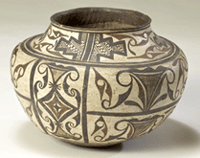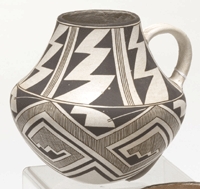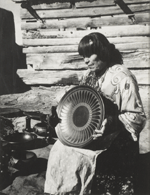|
Cowan's
Corner
Southwest Ceramics Meld Form and Function
By Wes Cowan
and Danica Farnand
I look across my desk and gaze at the gracefully shaped Zia olla sitting on
the shelf. Its four-color design dances across its body and around its shoulder.
And as I follow the rhythmic pattern of the delicate lines, I begin to think
about the woman who made this jar and the time and talent needed to prepare such
a masterpiece.
The late 19th century was the dawn of American Anthropology.
Men such as John W. Powell, Jesse Walter Fewkes, Harold S. Colton, and Edgar L.
Hewett researched and recorded southwestern cultures both historic and
prehistoric. During their ethnological and archeological studies, a new,
unexplored world was discovered and sent east. Photographs, reports and
artifacts were brought to museums, institutions and World Fairs, inciting
interest and instigating western travel.
As these anthropologists attempted
to understand prehistoric aboriginal cultures of the West, they often requested
the help of contemporary Puebloan potters. In 1909, Edgar Hewett unearthed shiny
black pottery shards during his excavations near Bandelier National Monument, in
northern New Mexico.
Hoping to recreate these vessels, he asked Maria
Martinez (1887-1980), a master potter of San Ildefonso Pueblo, to help. She and
her husband Julian redeveloped and perfected a firing process called
oxygen-reduction firing a technique that allowed her to obtain both a high
gloss and black matte finish. As the pots were fired, and after the kiln
temperature had reached maximum heat, manure was used to smother the flames. The
pottery enveloped by carbon-filled smoke turned it black. Maria's black-on-black
work is highly desirable, in part because three in five pieces broke during
firing, but also because of her mesmerizing forms and decorations.
Other
women ceramicists, such as Nampeyo (1860-1942, Hopi) with her steady hand and
attraction to her ancestor's designs and shapes, revitalized the 15th century
Sikyatki-style of pottery. These elegant, squat-shaped vessels with wide body
and narrow opening are highly sought. At auction, her pieces can bring up to of
$25,000. Lucy Lewis (1902-1992, Acoma), a matriarch of Acoma pottery making,
also incorporated the designs of her predecessors. She is known for finely
executing 12th and 14th century imagery of the Mimbres and Anasazi cultures.
Complica-ted geometrics integrated with a variety of animals can keep your eye
busy for hours.
Other jars created by less well-known potters are equally as
desirable and attractive. Large water jars called ollas had both the physical
design to be effective carrying vessels and aesthetic merit. Early jars had a
sharp shoulder that helped the woman grab a hold, and an indentation in the base
allowed her to balance the jar on her head and transport it home. Beautiful
designs of water birds, Avanyu the sea serpent, and heartline deer painted on
the body were executed with two purposes in mind.
The clay slip to which
these designs were applied, sealed the outside of the pot. Although the vessels
are semi-porous, only a small amount of water evaporates. The slow transfer of
water from inside to outside naturally cools and refreshes the water.
Values
on these types of jars vary by the size, age and pueblo. Ollas circa 1890-1900s
with 12" diameters can bring thousands of dollars, while smaller pieces from the
1920s may bring several hundred.
The turn of the last century brought about
a revitalization of Puebloan ceramics, of which the delicacy of form and design
cannot be denied. Today, the potting tradition continues, revisiting century old
shapes and designs, with contemporary innovative whimsical creatures grounded in
folktales or simply the potter's mind. Any trip to the West will open up a world
of magic, not unlike the magic experienced by some of the early visitors.
 About the Author: Wes Cowan is founder and owner of Cowan's Auctions, Inc. in
Cincinnati, Ohio. An internationally recognized expert in historic Americana, Wes stars in the
PBS television series History Detectives and is a featured appraiser on Antiques Roadshow.
He can be reached via email at info@historicamericana.com. About the Author: Wes Cowan is founder and owner of Cowan's Auctions, Inc. in
Cincinnati, Ohio. An internationally recognized expert in historic Americana, Wes stars in the
PBS television series History Detectives and is a featured appraiser on Antiques Roadshow.
He can be reached via email at info@historicamericana.com.

Article research by Danica
Farnand.
|

Zuni Olla collected during the Wheeler Survey
(1869-1879), 8.25" x 12",
$12,650.

Acoma handled jar potted by Lucy Lewis in 1959, 6.25" x 6.5", $1,440.

Maria Martinez holding
a black-on-black plate.
|